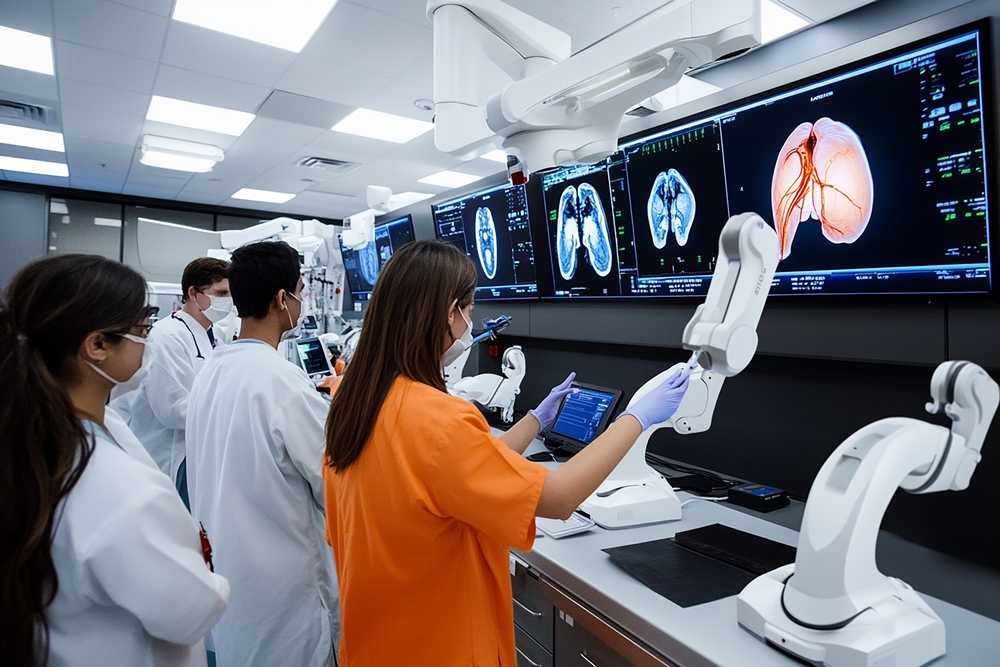
Health Tech World explores the latest research developments in the world of health technology.
Mini-camera and AI predicts recurrent heart attack
Measurements with a miniature camera inside the coronary arteries can accurately predict whether someone will suffer a recurrent heart attack.
Until now, interpreting these images was so complex that only specialized laboratories could perform it.
A new study from Radboud university medical center shows that AI can reliably take over this analysis and rapidly assess arteries for weak spots.
To better identify vulnerable spots within the artery that can trigger new infarctions, technical physician Jos Thannhauser and physician Rick Volleberg of Radboudumc, together with their team, conducted a study.
They analysed the coronary arteries of 438 patients using a miniature camera and specially developed AI, and followed these patients for two years.
The study shows that AI detects vulnerable spots in the arterial wall just as well as specialized laboratories, the international gold standard, and even predicts new infarctions or death within two years more accurately.
The miniature camera uses a technique called optical coherence tomography (OCT). Inserted through the arm into the bloodstream, it captures images of arteries using near-infrared light, visualising the vessel wall at microscopic resolution.
New orthopaedic technology enables pin-free robotic surgery
Scientists have developed a pioneering robot-assisted procedure for joint replacement surgery.
The approach removes the need for bone pins and external infrared cameras in procedures such as knee replacement surgery.
Led by Professor Stefan Landgraeber at Saarland University’s Homburg Campus, and research associate Philipp Winter, the project seeks to make orthopaedic surgery both safer and less invasive.
Until now, the surgical robots deployed in orthopaedic and trauma surgery have made use of ‘bone pins’ – metal pins approximately 3.2 millimetres thick that are anchored directly into the bone.
These pins allow the robot to determine the bone’s exact position in the body using an infrared tracking system.
However, this method carries risks, including bone fractures and damage to muscles or soft tissue. The new approach eliminates the need for the pins and for the external camera system. Instead, the robot uses its own built-in sensors.
By precisely scanning a defined structure, such as a bone or a prosthesis, the robot can determine its spatial position and generate a three-dimensional model of the surgical field. This process is further supported by X-ray images taken in two planes.
The key innovation lies in the robot’s internal coordinate system, which determines its spatial relationship to the surgical object and replaces the need for infrared tracking.
A patent application for the technology has already been filed. The team from ‘Triathlon – Integrated Ecosystem for Entrepreneurship, Innovation and Transfer at Saarland University’ supported the patent marketing and commercialisation process.
With the introduction of this new method, the researchers are making a major contribution to the advancement of robot-assisted surgery.
CRISPR’s efficiency triples with DNA-wrapped nanoparticles
Chemists have unveiled a new type of nanostructure that dramatically improves CRISPR delivery and potentially extends its scope of utility.
Called lipid nanoparticle spherical nucleic acids (LNP-SNAs), these tiny structures carry the full set of CRISPR editing tools wrapped in a dense, protective shell of DNA.
Not only does this DNA coating shield its cargo, but it also dictates which organs and tissues the LNP-SNAs travel to and makes it easier for them to enter cells.
In lab tests across various human and animal cell types, the LNP-SNAs entered cells up to three times more effectively than the standard lipid particle delivery systems used for Covid-19 vaccines, caused far less toxicity and boosted gene-editing efficiency threefold.
The new nanostructures also improved the success rate of precise DNA repairs by more than 60 per cent compared to current methods.
The study from Northwestern University paves the way for safer, more reliable genetic medicines and underscores the importance of how a nanomaterial’s structure, rather than its ingredients alone, can determine its potency.
AI accurately identifies atrial fibrillation patients needing blood thinners to prevent stroke
Mount Sinai researchers have developed an AI model to make individualised treatment recommendations for atrial fibrillation (AF) patients.
The AI has been developed to help clinicians accurately decide whether or not to treat them with anticoagulants (blood thinner medications) to prevent stroke, which is currently the standard treatment course in this patient population.
This model presents a completely new approach for how clinical decisions are made for AF patients and could represent a potential paradigm shift in this area.
In the study, the AI model recommended against anticoagulant treatment for up to half of the AF patients who otherwise would have received it based on standard-of-care tools.
Evaluating chatbot accuracy in the fast-changing blood cancer field
Patients are increasingly turning to AI for medical information and even advice, but how should they approach using AI-powered services?
A new study provides insight into this question for the fast-moving field of blood cancer, evaluating the quality of responses by ChatGPT to a set of 10 medical questions.
The study investigated ChatGPT 3.5, a version of the popular chatbot from OpenAI that was freely available when the study was conducted, in July 2024. Four anonymous hematology-oncology physicians evaluated the answers.
ChatGPT 3.5 performed best at general questions but struggled with providing information about newer therapies and approaches, the study showed.
Prior to the new study, information on how LLMs performed on hematology-oncology tasks was lacking. Other researchers had evaluated LLMs for their ability to address general medical information or other areas of cancer.
For instance, ChatGPT 3.5 provided correct answers about cervical cancer prevention and survivorship, but was far less accurate about diagnosis and treatment.
Focusing on hematology-oncology provides an opportunity to test performance in a field with rapidly shifting treatment options, often tailored to unique patient profiles.
The researchers posed 10 questions to the bot, similar to patient questions as they progress through treatment. Five were general questions often asked when patients are first diagnosed, such as, “What are the common side effects of chemotherapy and how can they be managed?”
The other questions were more specific, such as “What is a BCL-2 inhibitor?” BCL-2 inhibitors are a class of drugs under active investigation.
The physician evaluators graded answers on a scale of 1 to 5, from “strongly disagree” to “strongly agree.” A score of 3 was neutral, meaning it was “neither accurate nor inaccurate; it is ambiguous or incomplete.”
ChatGPT earned an average score of 3.38 on general cancer questions and 3.06 on questions about newer therapies. None of the evaluators gave the bot a score of 5 on any of the answers.
“Physician oversight remains essential for vetting AI-generated medical information before patient use,” concluded the researchers.
One limitation was that the study did not test other LLMs or newer versions of ChatGPT. After all, ChatGPT 3.5 was trained on datasets with a 2021 cutoff date, limiting its analysis of new medical developments.
Hybrid polymer-CNT electrodes developed for safer brain-machine interfaces
Brain–computer interfaces are technologies that enable direct communication between brain activity and external devices, enabling researchers to monitor and interpret brain signals in real time.
These connections often involve arrays of tiny, hair-like electrodes called “microelectrodes” which are implanted within the brain to record or stimulate electrical activity.
For decades, microelectrodes have faced a challenge in balancing conductivity with tissue compatibility. Rigid metal or silicon-based electrodes enable stable signal recordings but often damage the delicate brain tissues, whereas softer polymer electrodes reduce harm but suffer from poor signal transmission.
Bridging this gap, a research team led by Associate Professor Jong Ok from the Department of Mechanical and Automotive Engineering, Seoul National University of Science and Technology, Seoul and Dr. Maesoon Im from Brain Science Institute, Korea Institute of Science and Technology (KIST) developed a microelectrode with three-dimensional “forests” of carbon nanotubes (CNTs) that efficiently conduct electricity like metals but also flex like soft tissue.
Embedded in an elastic polymer base, the arrays are approximately 4,000 times softer than silicon and about 100 times softer than polyimide.
To fabricate these arrays, the researchers used a multi-step process for vertical growth of CNTs and a proprietary polymer-CNT hybridisation technique.
The resultant arrays demonstrated stable insertion in brain tissues, enabling precise recording of the visual responses.
The arrays also showed a marked reduction of inflammatory responses compared to tungsten microwires, making them a promising option for safer brain applications.
The in-vivo experiments in mice also validated the device’s capacity to record light-evoked responses from visual cortex neurons (visual center present at the back of the brain).
Additionally, one-month implantation of CNT arrays showed lower activation of astrocytes and microglial cells (cells involved in immune response) than those observed in conventional electrodes, highlighting the superior long-term compatibility of CNT arrays.
The findings open possibilities for use in visual prosthetics, especially for patients with retinal degeneration or optic nerve damage. Additionally, the technology could also be extended to cortical implants for brain-machine interfaces and tools for studying visual processing in neuroscience.







